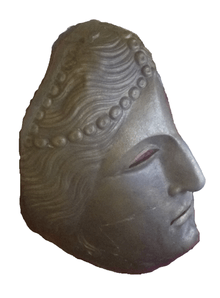Castra of Cincșor
The castra of Cincșor was a fort in the Roman province of Dacia in the 2nd and 3rd centuries AD.[1][2]
| Castra of Cincșor | |
|---|---|
 Location within Romania | |
| Known also as | Castra of Voila |
| Founded | 2nd century AD[1][2] |
| Abandoned | 3rd century AD[1][2] |
| Place in the Roman world | |
| Province | Dacia |
| Administrative unit | Dacia Apulensis |
| Administrative unit | Dacia Superior |
| Limes | Alutanus |
| Nearby water | Alutus |
| Directly connected to | |
| Structure | |
| — Stone structure — | |
| Size and area | (2.5 [3] ha) |
| Stationed military units | |
| — Cohorts — | |
| II Flavia Bessorum | |
| Location | |
| Coordinates | 45.84252°N 24.86661°E |
| Altitude | 545 m (1,788 ft) |
| Place name | Grădiște |
| Town | Cincşor |
| County | Brașov |
| Country | |
| Reference | |
| RO-LMI | BV-I-s-A-11266[2] |
| RO-RAN | 42325.01[1] |
| Site notes | |
| Recognition | |
| Condition | Ruined |
| Excavation dates | |
| Archaeologists | |
Location
The ruins of this cohort fort are located about two kilometers east of the village Cincșor, commune Voila, and about one kilometer north of the river Olt in the corridor "Burgstadt". In ancient times, it probably had the task of monitoring the movement of goods on the Olt and the Cincu Pass to the north. Nothing more of the Roman military camp can be seen in today's landscape.
Finds
During the archaeological excavations of the years 1974/1975 and 1979 to 1992, small trenches were dug determining the location of the fort. Two construction phases could be distinguished.
It is possible that there was initially a wood-and-earth storage facility, which was later replaced by a stone fort. The stone fort had a rectangular ground plan but the dimensions could not be determined. On the west side of the stone fort, a defensive wall and four ditches were found. Due to the small material found, the dating is uncertain, but epigraphic finds could identify the Cohors II Flavia Bessorum as the stationed unit.
A funerary inscription for a Roman military official, L. Carvilius Rusticinus, was discovered near the castra.[4]
In 1986 an excavator discovered a bronze parade mask nearby the fort, in the area of the reservoir lake. The mask depicts a woman's head. It has 24.5 cm height, 17 cm width and 14.5 cm depth.[5]
Exhibition
The archaeological finds can be found in the Muzeul Țării Țării[6] in Făgăraș and in Muzeul Județean Brașov[7] in Brașov.[8]
Monument protection
The entire archaeological site and in particular the fort are protected as historical monuments according to Act No. 422/2001 of 2001 and are protected with the LMI-Code BV-I-s-A-11266 in the National List of Historical Monuments.[2], in particular the Directorate-General for National Cultural Heritage, the Department of Fine Arts and the National Commission for Historical Monuments and other institutions subordinate to the Ministry, is responsible for this. Unauthorised excavations and the export of antique objects are prohibited in Romania.
See also
- List of castra
External links
Notes
- "42325.01". National Archaeological Record of Romania (RAN). ran.cimec.ro. 2009-05-13. Archived from the original on 4 March 2016. Retrieved 5 January 2013.
- "Lista Monumentelor Istorice 2010 ("2010 List of Historic Monuments")" (PDF). Monitorul Oficial al României, Partea I, Nr. 670 ("Romania's Official Journal, Part I, Nr. 670"), page 578. Ministerul Culturii şi Patrimoniului Naţional. 1 October 2010. Archived from the original (PDF) on 10 June 2012. Retrieved 5 January 2013.
- "Cincsor". STRATEG MAPS: Defensive strategies and trans-border policies at the Lower Danube in Roman Antiquity (An interdisciplinary project). Archived from the original on 14 May 2012. Retrieved 5 January 2013.
- Carol-Opriş, Ioan; Raţiu, Alexandru; Stoian, Gabriel, Stadiul cercetării siturilor din jud. Braşov şi Covasna ("Stage of the research in Braşov and Covasna Counties"), Raport ştiinţific Privind Derularea Proiectului Strategii Defensive şi Politici Transfrontaliere: Integrarea Spaţiului Dunării De Jos în Civilizaţia Romană (STRATEG) ("Scientific Report on the Progress of the Project "Defensive Strategies and Border Policies: Integration of the Lower Danube Region in Roman Civilization (STRATEG)""), pp. 37-, www.academia.edu, retrieved 5 January 2013
- "Comorile Făgăraşului".
- Official website of the museum (Romanian), retrieved on the 4th day of the excavation. January 2019
- Official website of the museum (Romanian), accessed on January 4, 2019

